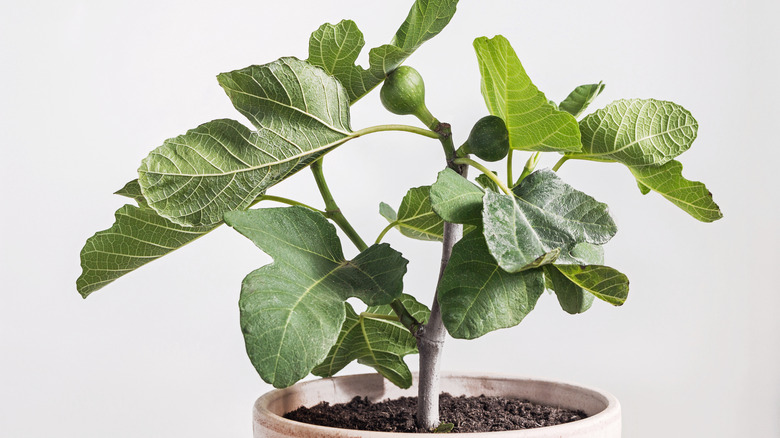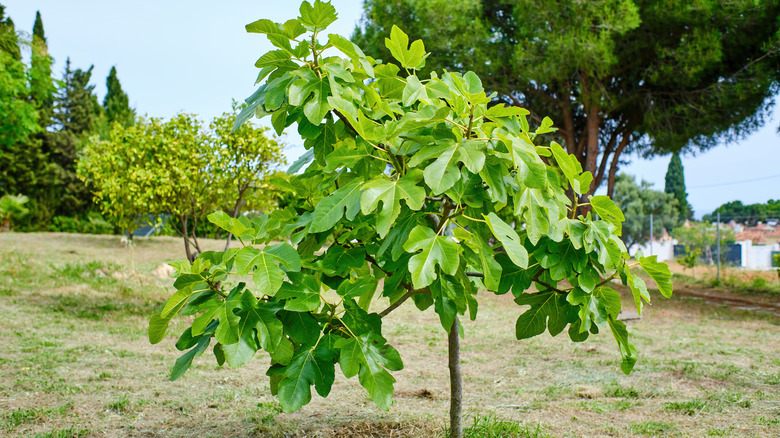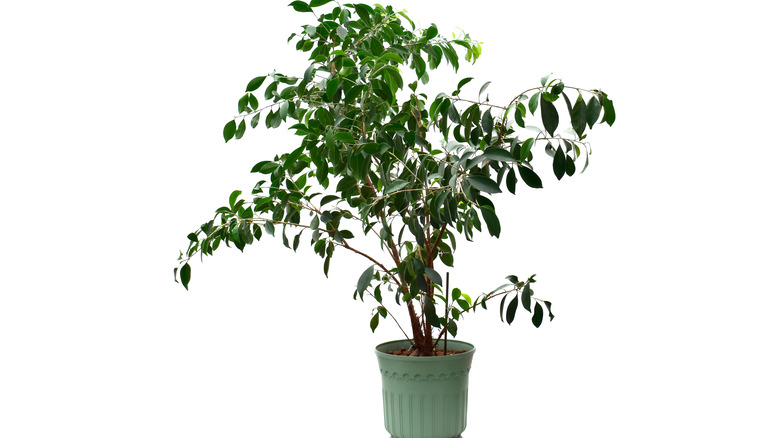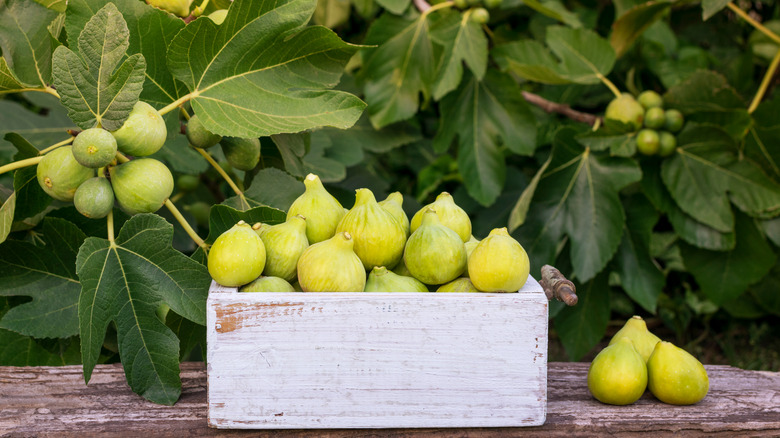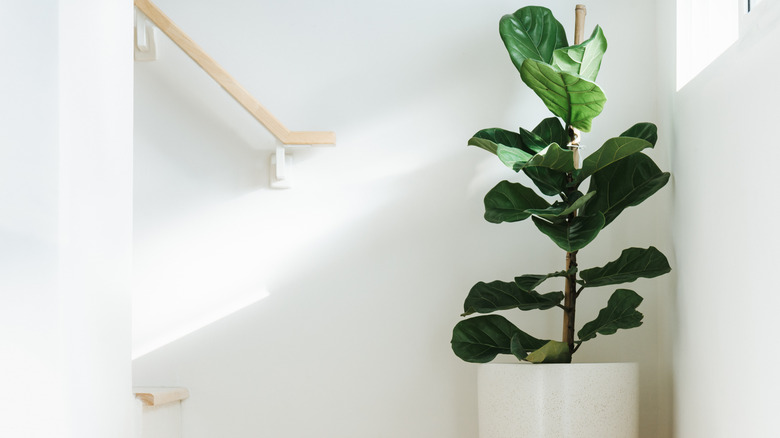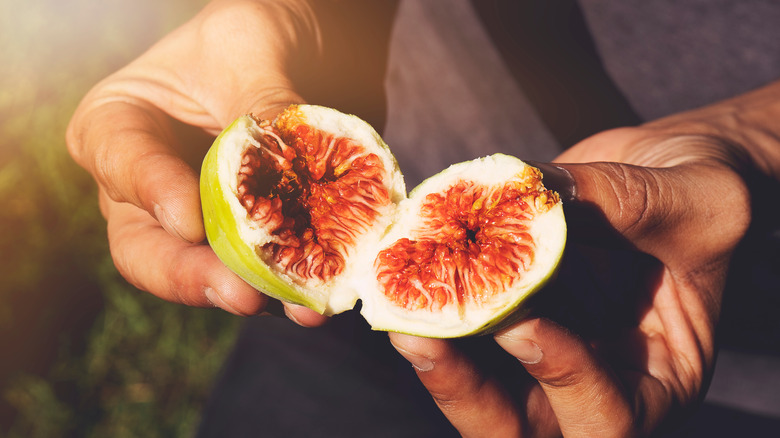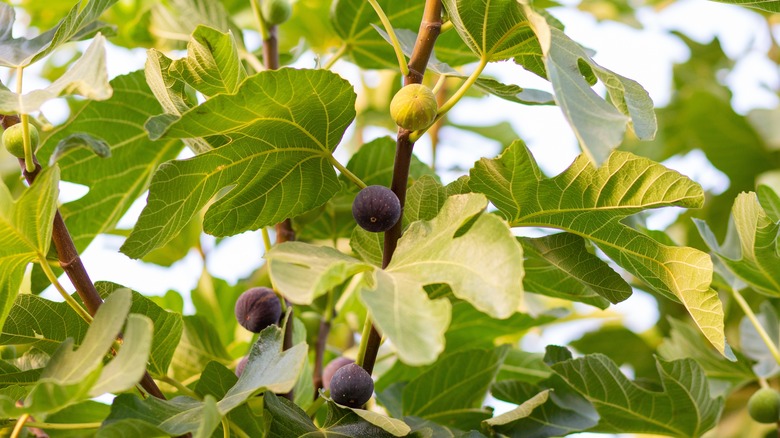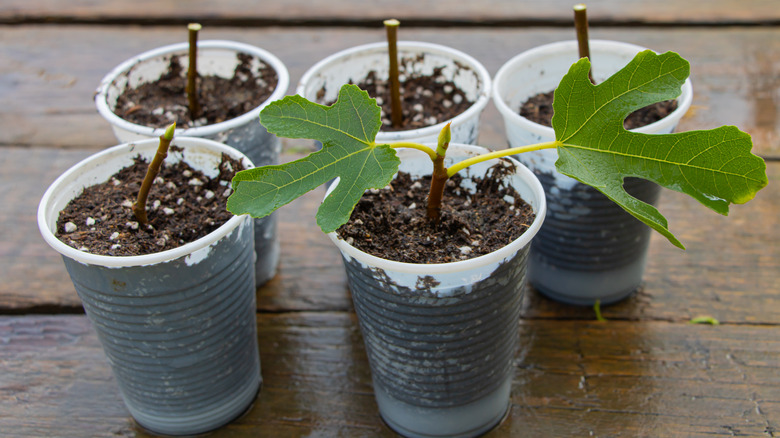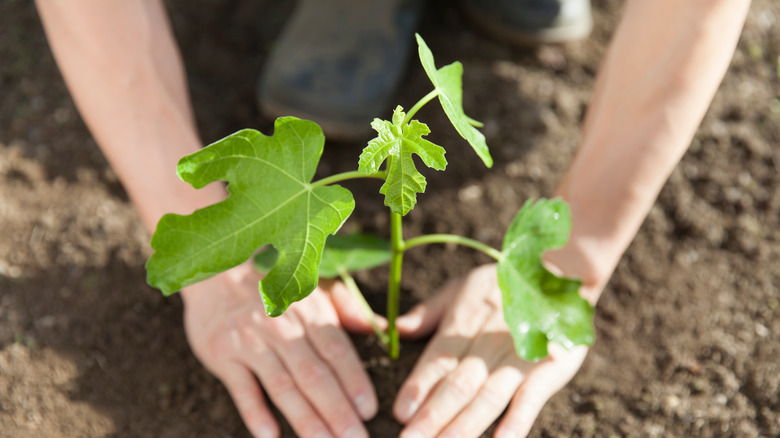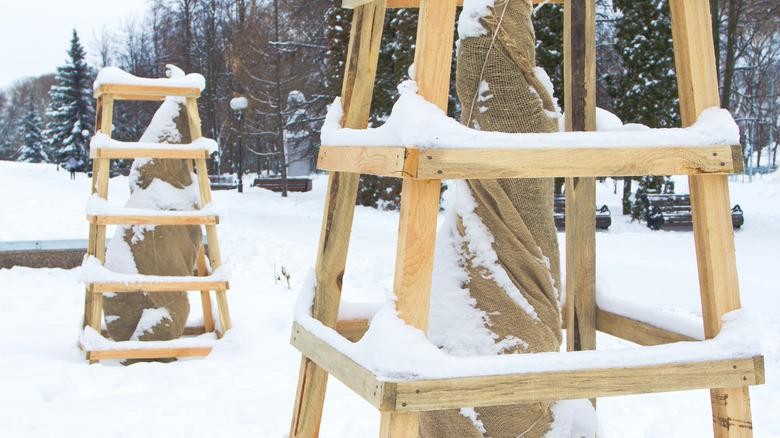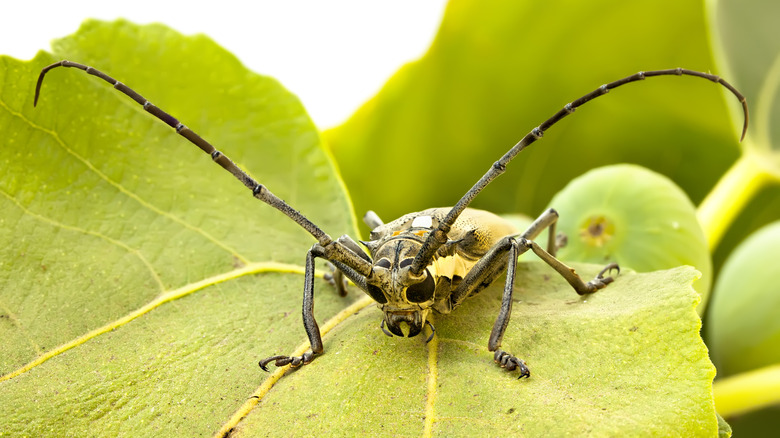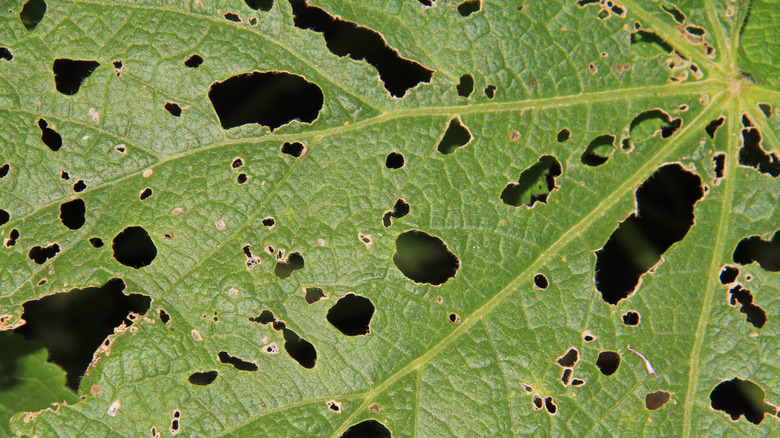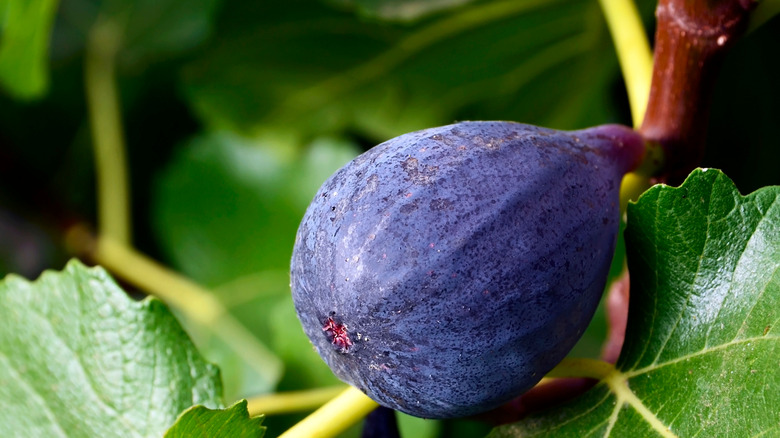Fig Tree: Everything You Should Know Before Planting
Fig trees, scientifically known as Ficus carica, are relatively easy small trees to grow and produce fruit. This species is the most popular variety of fig trees because it thrives even when it is neglected. It is also a species of plants that doesn't need to be pollinated in order to produce fruit, according to Tucson.
The first fig tree can be dated back to about 11,000 years ago in the Middle East, and because of their country of origin, fig trees love hot climates, Tucson notes. In the United States, fig trees do best in South and Western states or when kept in a greenhouse during the winter months. However, it can take up to 10 years before fig trees begin growing fruit; this is because they need to establish their root system before the plant can focus on growing fruit. However, figs are worth the wait with their sweet honey and berry flavor.
How to use fig trees in your garden
There are two options when planting a fig tree: You can either keep it in a pot or plant it in the ground. If you choose to have your fig tree in a pot, you will need to choose an appropriately sized container and potting soil mix with lots of drainage ability. Having a fig tree in a pot is convenient because you can relocate it when the climate gets too cold or move it to a sunnier spot in your garden.
Planting a fig tree in the ground comes with a couple of caveats. For instance, fig tree roots are very strong, so you need to be careful where you place your tree. They can damage walls, driveways, and homes, so they should be planted at least 20 feet away from important structures. Otherwise, you mainly only need to be concerned with the climate, because, according to the Almanac, fig trees should be planted outdoors in USDA Zone 8. They can take long, hot summers, but not winter weather that drops below 10°F.
How to grow a fig tree
You won't need any special tools to grow a fig tree. It is not a finicky plant, so it will thrive even with some neglect. However, if you choose to plant your tree in a pot, you will need to choose the correct size pot. To do this, look at the root ball of the tree. Using that as a guide, choose a container that is a couple of inches larger around and deeper than the root ball. The type of soil being used is also important. Since fig trees originated in the Middle East, they prefer sandy soil, but you can replicate this by mixing a soil-based potting mix with bark chips.
Furthermore, pruning is also important when caring for this tree type. You can do it in the fall to early spring time when the plant is dormant. To prune a fig tree, simply cut off branches that look dead, diseased, or weak, Lawn Starter explains. The same pruning idea also goes for the tree's fruit. To promote bigger figs to grow, remove excess unripe fruits — this will cause the plant to focus its energy on growing the figs that are left, making them larger.
How to care for a fig tree
Caring for a fig tree differs depending on whether it is planted in a pot or in the ground. Fig trees in pots need to be regularly fertilized during the growing season, while trees in the ground do not. This is because these plants love plenty of sunlight, but in order to grow fruit, they need to be in the sun for at least seven to eight hours a day. In a pot, fig trees should be watered around every two weeks and fertilized every four weeks (via the Almanac).
If a fig tree is planted in the ground, you should water it at least 1 inch every week. This can either be from rain or a garden hose. Be careful not to overwater, though, because fig trees prefer a dryer climate. Fig trees planted in the ground don't need to be fertilized because the dirt in the ground already contains organic material. Whether in a container or in the ground, fig trees thrive with a lot of sunlight — they can handle full to partial sun.
Fig tree varieties
Fig trees are some of the oldest crops in the records. They fall into the Ficus genus, along with about 850 different species of the plant, Tucson says. All these varieties have their similarities and differences. The most common species is the Ficus carica, which has its own varieties; some of those include the Brown Turkey fig, Kadota fig, and Celeste fig. Of all the different types of fig trees, wild species are used for harvesting, and common varieties are grown by everyday plant owners.
There are also hardier varieties of fig tree, which can withstand the colder temperatures in USDA Zone 6 and USDA Zone 7, such as the Chicago hardy fig tree. Some types even need to be pollinated by specific wasps in order to grow fruit, like the Bearded fig tree. According to Gardner's Path, fig trees can even grow up to 30 feet tall and attain almost the same length wide.
Are fig trees toxic?
Fig trees produce delicious fruits, but it is the tree itself that you need to be careful of. Pets and children should not be left alone around it. The fruit produced by fig trees is safe for humans and dogs to eat but is toxic to cats. The sap from fig trees is what is dangerous to humans and all pets, and according to Gardening Channel, what makes the sap toxic are the psoralen and bergapten compounds that it contains. If ingested, the sap will cause painful gastrointestinal symptoms. This includes drooling, vomiting, and diarrhea.
The sap can also cause skin irritation. When the compounds in it are exposed to the sun, Gardening Channel explains that it produces phytophotodermatitis. This reaction causes human and pet skin to be irritated with redness, itching, and burning. In extreme cases, blisters can even occur and leave scarring. If you have or want a fig tree and have pets or young children, it's best to keep the plant in a separate area, like a greenhouse, where they can't access it.
How to repot a fig tree
Repotting a fig tree can be difficult, depending on how large it is. If you have a larger plant, it may be beneficial to lay it on its side while removing and replacing the pot. When repotting a fig tree, you will want to wait until it is dormant — this is any time from fall to early spring time. Once you have all the necessary supplies, like a properly sized container and fast-draining soil or a sunny spot in your yard, it is time to remove the fig tree from its original pot.
If the roots are bound, you can pull them apart with your hands and even use shears to cut through some of them. Then you will either need to put some of the soil in the new pot or dig a hole in the ground. If you are choosing to plant it in the ground, the Almanac recommends digging a hole that is 2 to 4 inches deeper and wider than the original pot. After adding more soil on top, water the fig tree heavily.
How to propagate fig trees
Unlike many other fruit trees, figs do not require grafting for propagation, notes Urban Farmstead. They're actually very easy to reproduce through cuttings. Use clean, sharp pruning shears to cut a thin branch at a point that is two to three buds away from the main thick branch or stem. This will help maintain the tree's overall size and shape while also giving you all you need for propagation. It's perfectly safe for the tree for you to take several cuttings.
Cuttings can be rooted in water. However, Urban Farmstead advises going directly to soil in 4-inch grow pots. For this task, you can try a cactus and succulent-specific potting mix for its excellent drainage capabilities, but it's not necessary, and any standard mix will do. Fill your grow pots with pre-moistened soil and use your finger to press holes in the center of each pot. For the best chances of successful rooting, trim your cuttings close to a leaf node, score the lower few inches of bark, and dip them into a rooting hormone before planting them into the grow pots. Adding a layer of mulch is good for retaining moisture, and a heat mat will go a long way to keep your cuttings comfortable. Water weekly or as needed, and you should see significant rooting and new growth in as little as three weeks. By eight weeks, your new baby trees will be ready to be transplanted into the yard or given away as fruitful gifts.
Can you grow a fig tree from seed?
Not only is it easy to propagate fig trees from cuttings, but it's also the preferred method because it guarantees a new tree that is just as healthy and full of fruit as its parent. New trees can be grown by seed, but the potential problem is a tree that bears no resemblance to its parent plant. Furthermore, male seedlings will only produce small fruits that no one wants to eat, so Garden Guides advises only growing figs from seed if your intention is decoration for the landscape. A final note before you attempt the arduous task of growing from seed: Even if you do end up with a tree that is going to produce fruit reliably, it can take as long as seven years for it to mature to the point of doing so.
For those who still want to go for it, pick fresh fruit by late spring or early summer. Soak them in water until they're soft enough to pull apart, discard any seeds that float and only use those that sink to the bottom of the bowl. Keep the seeds wet as you fill grow pots with a potting mix specific to seed starting. Give the seeds a gentle press into the top of the soil, but keep them uncovered; Garden Guides recommends protecting the grow pots with plastic wrap. Seed germination requires consistent warm temperatures and exposure to plenty of natural light. Seedlings should live out their first winter indoors. Do not transplant them outside until the final spring frost has come and gone.
How to winterize fig trees
Even though sub-tropical fig trees require a significant number of chill hours to produce fruit, they cannot survive winter temperatures below 20 degrees Fahrenheit. This makes it vital to know how to winterize them properly. If you keep your trees in containers, simply move them into a garage or basement. Per Penn State Extension, this area needs to be dark and insulated, yet unheated.
Winterizing an in-ground fig tree is not a project for the faint-hearted. Here's the rundown of tools and materials needed for a single tree, according to Brooklyn Botanic Garden: pruning shears, twine, shredded leaves, 60 square feet of burlap, three stakes long enough to frame the tree, a post-pounder tool or hammer, 12 feet of chicken wire, tar paper, duct tape, a plastic bucket, and a step stool. If you're still with us, let's explore the steps you'll take for success.
The first thing to do is give your tree a solid pruning, and know in advance that it's normal for a fig tree to die back all the way to its base. After pruning, use the stakes and chicken wire to create a frame that tapers at the top. Next comes the tar paper because it will offer a water-repellent environment. Wrap it around the chicken wire, securing it with tape as you go. The shredded leaves go inside the frame, which will act as insulation. Cut and fold the chicken wire and tar paper so the top continues to taper — this is where the step stool will come in handy. Now, take that plastic bucket and flip it upside down over the top hole for a truly waterproof cover. Finally, wrap the whole bucket-topped fig tree statue in burlap and secure it with twine.
Pests to watch out for with fig trees
Pictured above, the fig tree borer (Phryneta spinator) is a large beetle known to eat, or bore, its way through fig tree trunks. You'll want to keep an eye on the branches, especially at the base, where a female beetle will lay eggs. Per Candide, if you see any slits or holes in the wood or residual sawdust nearby, these could be signs that you've got fig tree borers and your tree needs attention. These destructive beetles can take down an entire tree, so it's best to start treatment as soon as possible. Non-chemical tactics include wrapping the trunk in mesh to act as a barrier, removing and killing grubs by hand, and planting garlic as a natural bug repellent. Synthetic pyrethroid is the way to go for a pesticide spray; just be sure to spray the actual bugs and not just the tree.
Other common pests include nematodes, carpenter worms, ants, earwigs, spider mites, and sap beetles, according to the University of California Agriculture & Natural Resources. Generally speaking, keeping the area surrounding your fig tree free from weeds, debris, and fallen fruit will do a lot to keep pests at bay. In some cases, insecticidal soap or pesticide sprays may be helpful, but it's important to correctly identify the pest and pair the proper chemical. For best results, consult a local nursery professional.
Common diseases with fig trees
Fungal diseases can occur with fig trees; the most common include surface mold, Aspergillus rot, Botrytis limb blight (Botrytis cinerea), and smut. The folks at PlantVillage advise minimizing the likelihood of these issues by harvesting mature figs before they have a chance to over-ripen and removing any fruit that falls to the ground, ensuring your tree receives adequate water, and pruning dead or decaying branches as well as any infected limbs. Another thing to note is high dust levels in your yard or garden, which can increase fungal issues.
A virus called fig mosaic can cause discoloration and yellow spots on leaves. Fig mosaic is often transmitted by fig blister mites (Aceria ficus), so controlling an infestation with horticultural oils and/or sulfur sprays will be your first line of defense. A similar-looking problem is called fig rust (Cerotelium fici), though the initial yellow spots caused by fig rust will turn reddish-brown and may cause blisters. It's important to note that fig rust spreads when leaves are sprayed with water. Instead, irrigate by drip directly to the soil and prune branches and leaves to allow for improved airflow around the tree. Per Plant Village, mulching and fertilizer can help, as will fungicides in extreme cases.
How long does it take for fig trees to bear fruit?
Patience is a virtue when it comes to growing a mighty fig tree. At a minimum, it will take three years for it to bear fruit, but that length of time is often closer to five years. In addition to the long initial wait, the first crop of fruit is usually not its best. Growers at Pepper's Home and Garden recommend ignoring this first batch and waiting until the tree's second year of fruiting to begin harvesting and enjoying its figs. Otherwise, you could be in for a most unpleasant and bitter bite.
According to Stark Bro's Nurseries & Orchards, you can tell that a fig is ripe when it turns purple. A few varieties, like Kadota and LSU gold, will still be green when they become palatable. However, you'll still know just by looking that they're ready to harvest because their size will cause them to bend their stems and dangle down from the branches. Squeezing the fruit is another way to identify a ripe fig; immature fruits remain firm, while ripe and ready fruits will be soft and squishy since they're full of sugary juice.
It's normal for some fully ripened fruit to fall to the ground. Otherwise, they will release from the stem with the gentlest pull. Leave figs on the tree for as long as possible so they can adequately ripen; unlike some other fruits, figs will not sweeten up if pulled from the tree too early. If you see milky white sap on the branch after harvesting a piece of fruit, it's a sign that the fig has not reached its full flavor potential. Stark Bro's recommends tasting one before harvesting anymore.
